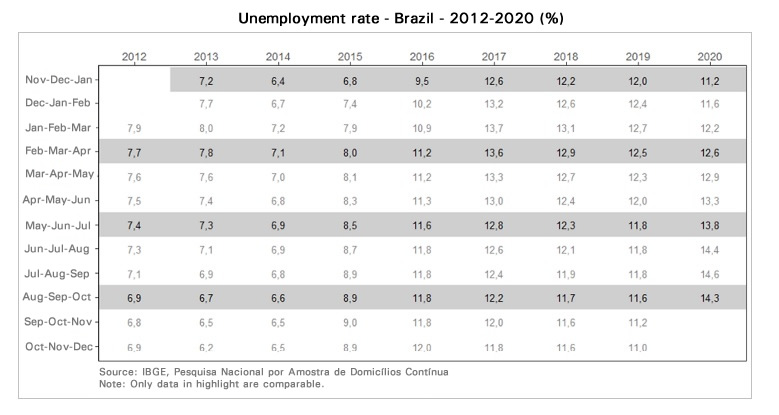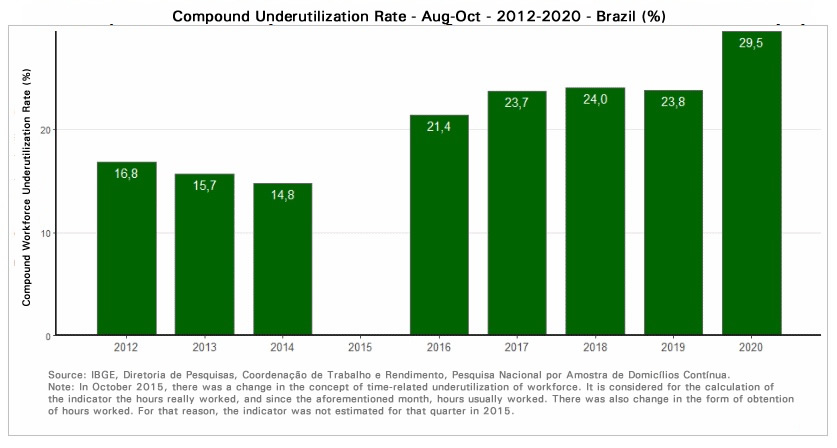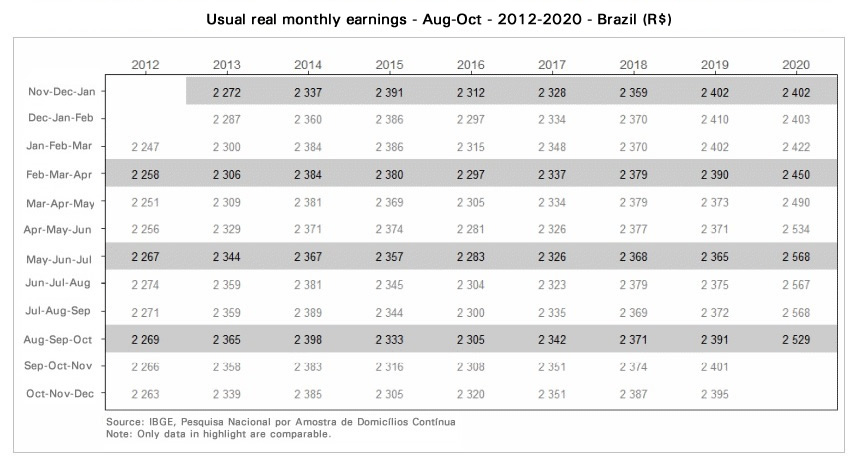Continuous PNAD: unemployment rate is 14.3% and underutilization rate is 29.5% in the quarter ended October
December 29, 2020 09h00 AM | Last Updated: December 29, 2020 09h42 PM
Unemployment rate (14.3%) in the Aug-Oct quarter in 2020 increased 0.5 percentage points (p.p) against the May-Jul period (13.8%) and 2.7 p.p. against the same quarter in 2019 (11.6%).
| Indicator/Period | Aug-Sep-Oct 2020 | May-Jun-Jul 2020 | Aug-Sep-Oct 2019 | ||
|---|---|---|---|---|---|
| Unemployment rate | 14.3% | 13.8% | 11.6% | ||
| Underutilization rate | 29.5% | 30.1% | 23.8% | ||
| Usual real earnings (R$) | 2,529 | 2,568 | 2,391 | ||
| Change of usual real earnings in relation to: | -1.5% (stable) | 5.8% | |||
The unemployed population (14.1 million persons) increased 7.1% (931 thousand persons more) against the same quarter and increased 13.7% (1.7 million persons more) against the same quarter in 2019.
The employed population (84.3 million persons) increased 2.8% (2.3 million persons more) against the previous quarter and fell 10.4% (9.8 million) against the same quarter in 2019.
The employment population ratio (48.0%) increased 0.9 p.p against the previous quarter and fell 6.9 p.p. versus the same quarter in 2019.
The compound underutilization rate (29.5%) fell 0.7 p.p. against the previous quarter and increased 5.7 p.p. against the same quarter in 2019 (23.8%). The underutilized population (32.5 million persons) did not change significantly against the previous quarter and rose 20.0% (5.4 million more) against the same quarter in 2019.
The population in the workforce (98.4 million persons) increased 3.4% (3.2 million persons more) against the previous quarter and fell 7.6% (8.1 million persons less) versus the same quarter in 2019. The population out of the workforce (77.2 million) fell 2.2% (1.8 million persons less) against the previous quarter and increased 19.0% (12.3 million more) against the same quarter in 2019.
The discouraged population (5.8 million) did not change significantly against the previous quarter and increased 25.0% (by 1.2 million persons) versus the same quarter in 2019.
The percentage of discouraged persons in the population out of the workforce (5.5%) was stable against the previous quarter and increased 1.4 percentage points versus the same quarter in 2019.
The number of workers with a formal employment contract in the private sector (29.8 million), except domestic workers, increased by 384 thousand persons against the preceding quarter, without significant statistical change, and fell 10.4% (by 3.4 million persons) against the same quarter in 2019. The number of workers without a formal contract in the private sector (9.5 million) increased by 9.0% (779 thousand persons more) against the previous quarter and fell 20.1% (by 2.4 million) against the same quarter in 2019. The number of
The number ofdomestic workers (4.7 million persons) did not change significantly against the previous quarter and fell by 25.5% (by 1.6 mllion) against the same quarter in 2019.
Informality rate hit 38.8% of the employed population (or 32.7 million informal workers). In the previous quarter, the rate was 37.4% and, in the same quarter in 2019, 41.2%.
The average usual real earnings(R$ 2,529) in the quarter ended October was statistically stable against the previous quarter (R$ 2,568) and increased 5.8% against the same quarter in 2019 (R$ 2,391). The usual real wage bill (R$ 207.9 billion) was stable against the previous quarter and fell by 5.3% (R$ 11.7 billion) against the same quarter in 2019.

In the groups of activity, against the previous quarter, employment increased in four of the ten groups: Agriculture, livestock, forestry production, fishing and aquaculture (3.8%), Industry (3.0%), Construction (10.7%) and Trade and repair of motor vehicles (4.4%). In the other groups, there were no statistically significant changes.
Against the same quarter in 2019, employment fell in eight of the ten groups: Industry (-10.6%), Construction (-13.7%), Trade, repair of motor vehicles and motorcycles (-11.2%), Transportation, storage and mailing activities (-13.4%), Lodging and feeding (-28.5%), Information, Communication and Financial, Real Estate and Administrative Activities (-4.0%), Other services (-20.4%) and Domestic services (-25.4%). In the other two groups there were no statistically significant changes.
Potential workforce (12.0 million persons) fell 14.0% (a decrease by 2.0 million persons) against the previous quarter and increased 54.9% (by 4.3 million) against the same quarter in 2019.
The number of persons of time-related underemployed persons (6.5 million) increased 11.9% against the previous quarter (by 688 thousand persons) and fell 7.8% (by 546 thousand persons) against the same quarter in 2019.

The number of employers (3.9 million persons) was stable against that in the previous quarter and fell 12.7% against the same quarter in 2019 (by 567 thousand persons).
The category of workers in the public sector (12.0 million persons), which includes civil servants and military workers remained stable in both comparisons.
The average usual real earnings from the main activity, against the previous quarter, fell in four groups of activity: Construction (-4.9%); Transportation, storage and mailing activities (-6.9%); Other services (-6.8%) and Domestic services (-4.7%). The other groups did not record significant changes.
Against the same quarter in 2019, earnings increased only in Industry (11.8%). Two groups recorded decrease: Transportation, storage and mailing activities (-5.6%) and Domestic services (-3.2%). There were no statistically significant changes in the other seven remaining groups.

The analysis of average usual real earnings from the main job, by employment status, against the previous quarter, recorded a decrease in two categories: Domestic worker (-4.7%) and Self-employed workers (-3.0%). The other positions did not record any significant changes.
Versus the same quarter in 2019, three categories recorded increase: Workers with a formal contract (3.4%); Workers without a formal contract (11.1%) and Civil servants (4.1%). The only decrease was that of Domestic workers (-3.2%). The other categories recorded stability.

